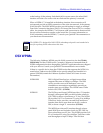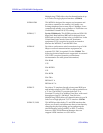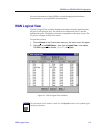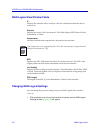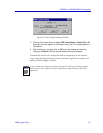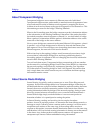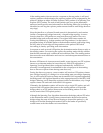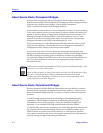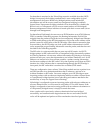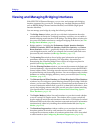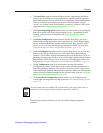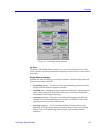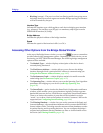
Bridging Basics 4-3
Bridging
If the sending station does not receive a response to the test packet, it will send
explorer packets to the destination; the explorer packets will be propagated by the
networkÕs bridges as either All Paths Explorer (APE) packets or as Spanning Tree
Explorer (STE) packets. The task of both packet types is to get the destination
station to return speciÞc route information to the sending station (by including an
identiÞer for each ring the explorer packet traversed and for each bridge between
any rings).
Since the data ßow on a Source Routed network is determined by end stations
(unlike a Transparently bridged network), a looped bridge topology is not an
issue for data ßow. APE packets are sent from the source station over every
possible bridge path to the end station. The original APE frame contains no
routing information (e.g., bridge numbers and ring numbers). As the frame is
propagated along all available paths to the destination station, each bridge along
the way adds its own bridge and ring numbers to the packetÕs RIF before
forwarding it, thereby providing route information.
In response to each received APE packet, the destination station directs a reply to
the sending station. On receiving the replies, the sending station ideally assumes
that the Þrst returned reply contains the most efÞcient route. The sending station
then stores the route information and uses it to send subsequent transmissions to
the same station.
Because APE frames do increase network trafÞc, some sites may use STE explorer
frames as an alternate method of route discovery. With STE exploration, a
Spanning Tree Algorithm (either conÞgured automatically via BPDUs or
manually via management) is maintained for the sole purpose of determining
how to direct an explorer frame during route discovery.
During the discovery process, a source station will send out STE explorer frames
into a bridged topology. If a bridge is in a forwarding state according to Spanning
Tree, it will forward an explorer frame onto its attached LAN segment (appending
the Bridge and LAN Segment IdentiÞers in the appropriate area of the RIF); if the
bridge is Þltering, it will discard the explorer frames. In this fashion, only a single
explorer frame will reach each individual LAN segment.
Ultimately, the destination station will receive only a single STE packet, and will
respond with APE packets (that return to the sending station on all possible
bridge paths) or an STE packet (that returns to the sending station via in the
reverse route of the STE explorer packet).
Although the Spanning Tree Algorithm determines the bridge path an STE takes
to the destination station, during future communication between the stations,
bridges along the route will use Source Routing to forward the packet (i.e., the
bridges will read the Routing Information Field in the header of speciÞcally
routed frames to decide whether to forward them).



